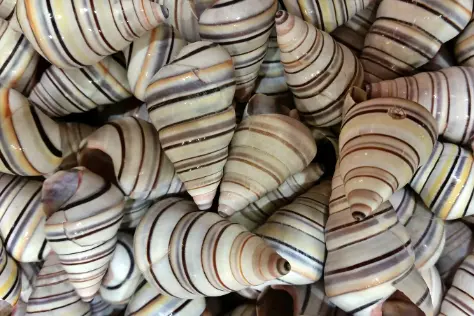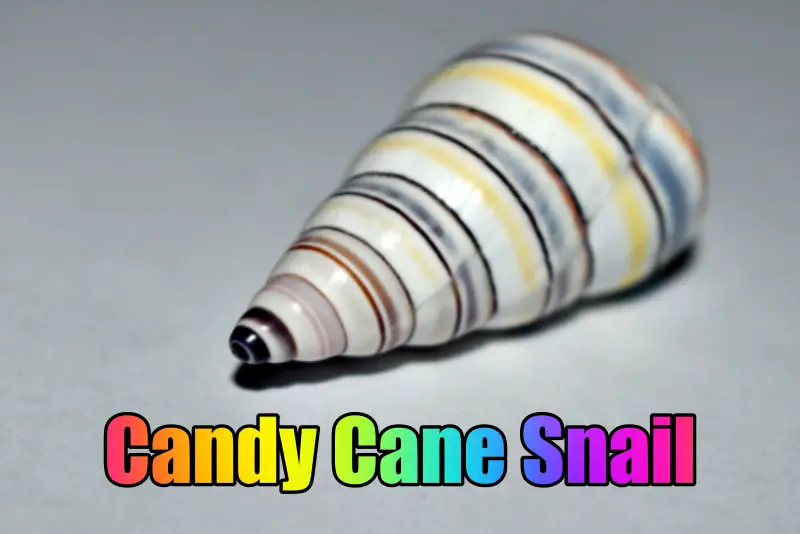What comes to mind as you hear the word “candy cane“? Candy often looks bright, festive-looking, and colorful. So, the candy cane snail too!
As one may expect, smooth and lustrous ground color of ivory-white with stripes of pink, red, black, purple, light yellow, etc., appear on the Candy cane snail’s shell. They appear similar to freshly painted holiday decorations. Amazing, isn’t it? Let’s learn more about these elegant yet rare species.
Candy Cane Snail: Wiki
The Caribbean Island of Hispaniola is home to the Liguus virgineus, or Virgin Liguus mostly referred as the candy cane snail. Although it lives in trees for the majority of its life, it lowers to lay its eggs in moist soil. Throughout its lifespan, it eats a variety of lichens, twigs, and small branches.
It was a food source for native people, as shown by the discovery of its shells in midden heaps in the Dominican Republic. The juvenile snails climb a tree after hatching.
While lichens that grow on bark make up the majority of the adult snail’s diet. Young ones, just hatched, will consume growing lichen first, then twigs and short branches, and ultimately lichen that grows on the bark.
The candy cane snail’s shell coloration, like that of other snails, is produced by chromophores, which are pigment glands in the mantle. These chromophores are active for the duration of an individual’s life, making up for the shell’s continuous colored lines.
| Scientific name | Liguus virgineus |
| Location | Caribbean Island of Hispaniola |
| Size | Shell size ranges between 30-60 mm |
| Diet | Fungi, moss, algae, and other microscopic organisms |
| Habitat | Tree-living species- on branches of the tree Haematoxylum campechianum. |
| Predators | Common predators of snails include mice, squirrels, shrews, toads, turtles, etc. |
| Colors | Various stripes of different colors like oink, yellow, brown, green, etc., over white base color |
| Price | Can be extremely expensive due to its attractive appearance and scarcity |
| About it | Tree-living snails with very attractive & colorful Shells, well-worthy but scarce species of snail |
Candy Cane Snail’s Appearance
What image of a snail do you have in mind? typical bland and monotonous colors? But the candy cane snails don’t resemble them in the least. They are arguably the world’s most colorful gastropods. Candy canes are more elongated and cone-like in shape than circular, like a garden snail.
Nearly too ornamental to be a real snail shell. These tiny, oval-conical shells are thin but sturdy.
The shell features seven or eight whorls, and its tip is not acutely pointed but rather blunt. The shell’s backdrop is white to off-white, or ivory, and it has one to six spiraling stripes that are often thin, colorful stripes in hues like brown and green, black, pink, purple, or light yellow.
Chromophores, which are pigment glands in the mantle, are responsible for their shell’s color. Also, the length of a candy cane snail’s shell can range from 30 to 60 millimeters (1.2 to 2.4 in). These tiny, thin, rigid shells have an oval-conical form. The shell’s exterior is lustrous and silky.
Liguus virgineus : Habitat & Geo Location
The candy cane snail is an arboreal creature that eats the microscopic algae, fungus, and moss that cover the bark of trees. Throughout its lifespan, it eats a variety of lichens as well as twigs and small branches.
Adults mostly eat lichens that grow on bark. Young that have just hatched will eat lichen growing on leaves. Twigs and little branches were next, followed by lichens that grew on the bark. We mean, this is precisely the order of their growing eating habits.
This land-dwelling gastropod is unique to one island in the Caribbean Sea that is part of the Greater Antilles. Hispaniola, the second-largest island in the region of the West Indies, is that island.
The Dominican Republic and the Haitian tribe can both be found on the island of Hispaniola.
Candy Cane Snail: Role in Marine Ecosystem

Snails and slugs are essential. They contribute to the environment’s equilibrium by serving as food for various mammals, birds, slow worms, earthworms, and insects. We, however, can cause a lot of damage to ourselves if we remove them and disturb that balance.
Given their rarity and current state of extinction, it is unknown how long these snails can survive. Not enough research has been done due to the same two reasons.
The snails provide calcium and other nutrients that are necessary for the development of nuclei and shells.
The majority of gastropods, however, are advantageous to humans since they aid in the breakdown of dead plants and animals, which plants can be used afterward to build new natural substances.
Some snails are so useful in farming practices that they are often admired as farming snails. They are more environmentally friendly than other animals because they do not emit a foul smell like pigs, chickens, etc. The organic content of the soil can be increased by using the snails’ droppings as manure.
But Why Are They Endangered?
Aptly named the “candy cane snail,” with a conical, vibrant shell – evocative of the candy cane banding. It lives in the Caribbean and is fighting to survive due to extinction caused by humans. As a result, it is forbidden to harvest these for their shells.
Their vibrant patterns have been appreciated for decades, but it all leads to its over-collection now, making it an endangered species.
What Are Those Conical Shells? What Makes Them Special?
Cone snails form a strong shell that expands outwards as they grow by adding calcium carbonate to the exposed edge of their shells.
All mollusks, whether terrestrial or aquatic, construct their own shells. An organ known as a mantle is used by organisms such as snails, clams, oysters, and mussels to release layers of calcium carbonate that crystallize and solidify. So now you know how the wonder works.
Just as most humans are right-handed, mollusks are physically biased toward the right, explaining why their shells spiral clockwise. (Extremely uncommon mutations can result in “left-handed” mollusks having counterclockwise spiraling shells.)
Compact and light in weight, these coiled shells effectively shield the snail’s soft bodies from predators—and, in the case of ocean mollusks, from waves and tides—while still being efficient to carry. Even though they constantly add to their shells as they age, mollusks never stop living in the same ones for the entirety of their lives.
Conclusion
In conclusion, Candy cane snails are unlike other snails in any way. They are extraordinarily colorful and pleasant in appearance. And this is one of the causes of the extinction of this species, the excessive hunting for candy cane snail shells.
Apart from this, there is very little data on the typical age of the species. Additionally, because they are only found in one area in the globe, the Caribbean Island, and because their populations are declining, they are difficult to locate, let alone research. In fact, it is against the law to gather and sell these shells.
These snails have stunning, unusual shells. The shell craft trade, however, has been overharvested for years. Its beauty has led to excessive shell collecting, making it difficult to find and putting the snail in danger. This species may also go extinct due to commercial exploitation and habitat degradation in forests.
FAQs
Q1. Is the candy cane snail endangered?
Ans. Its shell’s aesthetically pleasing appearance contributed to its extensive collection. Loss of habitat is another factor that has made it an endangered species. In fact, harvesting them for their shells is now illegal.
Q2. What are the candy cane snail predators?
Ans. Common predators of snails are mice, squirrels, shrews, toads, turtles, beetles, snakes, and birds, etc.
Q3. What habitat do Liguus virgineus prefer?
Ans. This snail is a tree-living species that exclusively prefer branches of the tree Haematoxylum campechianum.
Also Read:

Anjali Prasad, a B. Pharm. graduate who works as a content writer for HowItSee, is based in Delhi. Except for her, not many people take the typical road from healthcare to writing. Her love of writing stemmed from her involvement in the college literature society and her early journaling at the age of 7. Hence, the love of learning and the spirit of exploration are what drew her to this career. You can find her on common social media like Instagram.
